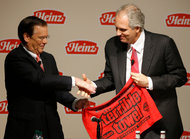To the Justice Department, a merger between American and US Airways would increase the fares and fees that have been steadily rising.
But to the airlines, the merger would lower costs and provide more flexibility for many travelers. What is more, some industry analysts said that a hobbled American, which is still trying to emerge from bankruptcy protection, would struggle to compete against the two giants, United Airlines and Delta Air Lines.
“What we are saying today is simply that they got this one wrong,” Richard Parker, a lawyer for US Airways, told reporters on Wednesday.
The Justice Department’s action comes after a decade of rapid consolidation in the airline industry, including the mergers of Delta and Northwest in 2008 and United and Continental in 2010. But antitrust officials said on Tuesday that despite the cost savings for the carriers from consolidation, domestic airfares, on average, had increased much faster than inflation over the last several years, prompting the department to revise its thinking about what was best for the consumer.
The Transportation Department has calculated that after adjusting for inflation, the average domestic airfare climbed to $379 in the first quarter of 2013 from $335 during the recession in 2009. And the fares varied greatly, often depending on the level of competition. For example, passengers in Huntsville, Ala., paid the highest fare, $543, in the first quarter while Atlantic City had the lowest, $169.
“I think the economics of the Justice Department is correct,” said George Hoffer, a transportation economics professor at the University of Richmond. “However, they are a day late and a dollar short. This should have been their decision in the Delta-Northwest case.”
But Mr. Hoffer said the airlines could prevail in court because the earlier mergers created “a structural disequilibrium” in the industry, with United and Delta having more flexibility to reroute passengers, especially lucrative corporate customers, when trouble arises.
Another issue is American’s ability to compete as a stand-alone airline. The Justice Department’s Antitrust Division argued that American could come out of bankruptcy as a strong competitor without the merger. It pointed to American’s order of 460 new airplanes over the next decade, worth $38 billion and billed as the largest single order in history, as well as its recent return to profitability.
But some financial and aviation analysts see it differently. American’s domestic network and hubs are considered weaker than Delta’s or United’s, and its international network is smaller. The airline is also part of Oneworld, the smallest of the three global airline alliances. American, which is owned by A.M.R., cut its costs through bankruptcy, but it did little to bridge the gap in revenues with its peers, which can command higher fares and attract more business travelers.
“Apparently, the Justice Department takes the position not held by most analysts, who viewed A.M.R.’s proposed stand-alone plan as unlikely to be competitive or to succeed,” said Robert W. Mann, an aviation consultant.
If the merger is blocked, the clear winners will be United and Delta, which have global ambitions, some analysts say. A smaller American will struggle to attract business travelers with its smaller domestic network and smaller international footprint.
John Godyn, an airline analyst at Morgan Stanley Research, wrote in a note to investors that Delta and United “would have a duopoly on corporate travel, superior networks and more valuable frequent flier programs.”
Professor Hoffer, however, said that American had done enough cost-cutting in recent years to hold on to its spot as the nation’s fourth-largest carrier. “Because the industry is more concentrated, it would be easier for American to raise capital and grow itself,” he said.

Article source: http://www.nytimes.com/2013/08/15/business/justice-dept-alters-view-of-mergers-by-airlines.html?partner=rss&emc=rss
